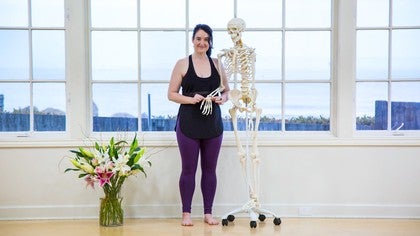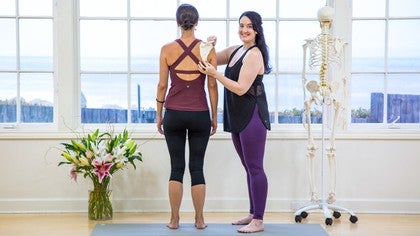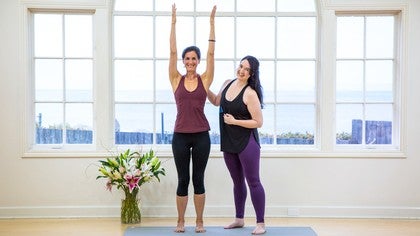Description
Please see attached .pdf below on the bones of the upper appendage.
About This Video
Transcript
Read Full Transcript
Our arms are what allow us to reach and grab and hug and embrace and to be touched and touch others. This is a vital part of our anatomy. Let's go through the beauty that is in the details. If you take your hand to your own sternum or breastbone, you're going to feel this little jugular notch, this little notch on the top, and you can find where your two collarbones or clavicles articulate. This is teeny tiny little articulation called the sternoclavicular joints.
And just give yourself a little wiggle, give yourself a little feel, and you can see this puny and delicate and graceful tiny, tiny, tiny little articulation. Now here's a shocker, the only bony attachment of your whole upper appendage to your torso is just this little articulation, just this little guy. This is what makes our arms wildly mobile, we can do all sorts of action with the arms, but because of that we lack some stability. So the arms really aren't great weight bearers, bearing your entire body weight on this puny little, beautiful little articulation. If you follow your hands, you can acknowledge your own little sassy, sexy collarbones.
They're not straight like a branch, nothing really in nature is. It has this S-shape and a little spiral action to it, which actually gives it more mobility over your curvy ribcage, right, so another highly mobile piece. If you walk your fingers around to the tops of your shoulders, kind of like where you'd put a handbag or a piece of luggage, that little V on the top of your shoulder is what's called the acromioclavicular joint. So this is where your scapula and your clavicle meet up or join. Let's take a closer look at the scapula.
There's a lot of points of interest for us on our two shoulder blades or two scapula. Our scapula or two scapula are like downward pointing triangles. They have a medial border. They have a lateral or axillary border, which is the fancy word for armpit, axilla. They have an inferior angle or bottom point.
They have a superior angle or top point. Then they have this really nice rise, little bony protuberance called the spine of the scapula, this rise of the scapula that turns into the acromium process, which then meets up with your collarbone or clavicle. We have on the front of the scapula, and you can feel it on yourself anteriorly called the coracoid process or crow's beak. If you take your hands underneath your collarbone, kind of in front of this deltoid cap inside the pec muscle here, you might be able to feel it if you did this little groovy shoulder action. You might be able to feel the crow's beak kind of nod his head under.
There's a lot of flesh on top of that, so it might be harder to feel. Moving down the road, we have our humerus, a long upper arm bone, which is also a ball and socket joint. Just like our other ball and socket joints that we looked at, our femoral acetabular joints, the glenohumeral joint, named for the glenoid fossa or the socket, and the head of the humerus, the ball, glenohumeral joint, has the same movements that the hip would have. It has flexion. It has extension.
It has abduction and adduction. It's got external rotation and internal rotation. And the combo platter, it can do circumduction or the chicken dance, either way. Even a little closer look here, it's a very shallow articulation. Let me show you some real human bones.
We have, of course, our scapula, a little more character. And then we have our humerus from two different people. Ball and socket joint of the shoulder, much more shallow of a fit than the ball and socket joint of the hip. If the hip was analogous to an orange sitting inside of a coffee cup, that deep, snugly congruent fit, the glenohumeral joint is more like an orange sitting on the coffee cup saucer. There's not a lot of the surface area of the orange or the head of the humerus to the saucer or the glenoid fossa.
It makes it much more mobile than the hip, but again, where we have more mobility, we have less stability and often more chance for injury. We all come in different shapes and sizes, even in our bones. And so if we look at this acromion process, we all come with a different size acromion process. Some are really lumpy bumpy and some are more puny and maybe projected in a different place. So watch what happens.
If I were this person and I were to take my arms either out to the side and up or forward and up, there's going to be a stopping point where no more movement's going to happen. So if I tell this student, inhale, bring your arms up alongside your ears, they're going to have their arms slightly forward of their head, not right up alongside their ears, right? And it'll be structurally impossible. And if you keep saying to them, well, keep going, keep trying, here, let me help you, and kind of pulling their arms back or giving them all these kind of contraptions to try to get more mobility, if it is structurally set in the cards where he has a larger acromion process or more lumpy bumpy bits, it ain't going to move and you're most likely going to cause injury rather than any kind of freedom. So keeping in mind, there's a stopping point for all of us and that's going to be a different place, right?
One way that we can help get a little bit more freedom, because we're not going to x-ray our students as they come through the door. So we really, it's hard to tell if it's muscular tension, in which case it might be movable, or bony compression, in which case it ain't going to go. So one way that we can get a little bit more movement is if we externally rotate the humerus before asking it to lift. So this is the point in our journey together where I ask you to take a pledge, humor me. So repeat after me.
I state your name, do solemnly swear that I will always ask for external rotation before I ask for flexion. So help me, Sheba. So this may sound silly, but I have like a spidey sense, I can sense if it's not happening somewhere in the world, because it sounds like really unhappy shoulders. If we externally rotate our humerus before we ask for movement, like lifting the arms overhead, whether that's through abduction or flexion, it is possible that we might be able to bypass the acromion process for a little bit longer. So that gives all of the muscles in between a little bit more breathing space, we don't bump the bones into one another, a little bit more ease in action.
All right, let's continue down. So terminating at the end of this humerus, we find its articulation with our two lower arm bones, called the ulna, which is on our pinky side of our forearms, and our radius, which is on the thumb side of our forearms. This is why in anatomical position, I said earlier, we're going to have to be a little fussy when we talk anatomical position, the palms will face forward. This way, the forearm bones are more or less parallel to one another. Your arm does this really cool thing, you can keep your arm, your humerus steady, and you can turn your palm towards the floor, or turn the palm up towards the ceiling.
So this is what's called pronation and supination. Now do this with me, externally rotate your humerus, clamp it in place, bring your arm about parallel to the floor, and then pronate your palm. I remember this like supinate, you're holding a cup of soup in your hands, and then you pro it to the floor, pronation. So pronating your palm, some of us won't be able to pronate the palm, so it's parallel to the floor. Some of us will stop about here.
That's fine, that might just be in the skeletal cards, or if you're typing a lot, or playing golf or tennis, this area might get very congested. Now if you can't get your palm to the floor though, in like say a downward facing dog, you're going to be forced to internally rotate your humerus before you ask for flexion, and you just took an oath, a solemn oath, that you wouldn't do that. So maybe for those students, a downward facing dog with the forearms on the floor, so you don't have to pronate quite so much. Different strokes for different folks. Your elbow joint is actually the articulation between your ulna and your humerus.
It fits in this little notch in the humerus called the trachlear notch. Now if you have a deeper notch, you might be able to hyper extend the elbow, or if you have a more puny little process, you might be able to hyper extend. If that notch is not so, is a little bit more shallow, you may not be able to hyper extend. You might only extend to that 180 degrees or so. If you've ever hit your funny bone, actually when that notch is exposed, when you're bending your elbow, there's a nerve that runs down to the arm, lower arm, and when the elbow is bent, that nerve is kind of exposed, so if you hit it, you get that sharp shooting tingly searing kind of nerve pain, not so funny.
Moving down, we see the termination of the radius and the ulna. You can see that on your own hand and feel that little bump on the inside medial aspect and outside lateral aspect of your wrist. And now we have our hand bones. We have our carpals, and each one has a different name. For our purpose, we can just call them as a team, the carpals.
We have eight on each hand, and they're kind of in more or less kind of two rows, like a kind of cobblestone street. The first set of carpals is actually, if you look at your own wrist or maybe my wrist, you'll see kind of two main wrist wrinkles, one near the palm of your hand, a little more dominant, a little bit more noticeable, and one a little bit less noticeable, maybe about a half an inch up. That is where the first line of carpals actually are. The second line of carpals is in the heel of your hand. So if you look at your hand built much differently than the foot, they're not really well suited to bear weight, these tiny little pebbles.
Looking beyond the carpals, we have our metacarpals. Metacarpals is a word that we use the prefix meaning to go beyond, so it's beyond the carpals. And then of course, just like our feet, we have our phalanges, our little finger bones. So you have three phalanges in each finger and two in each thumb. So when we're talking about the upper appendage or the shoulder in particular, the shoulder can be thought of as being made up of a few different joints.
The shoulder girdle comprising of the clavicle, the scapula, and the humerus. And the joints that we're looking more closely at, the sternoclavicular joint, a chromoclavicular joint, and glenohumeral joint. Now if we have now the audacity to bear weight on our arms, learning our structure, learning how individual our structure shows up, this is going to set ourselves up for success in doing all these wild postures that we might want to enter into.
Your Body on Yoga: Upper Appendage
Comments
You need to be a subscriber to post a comment.
Please Log In or Create an Account to start your free trial.












